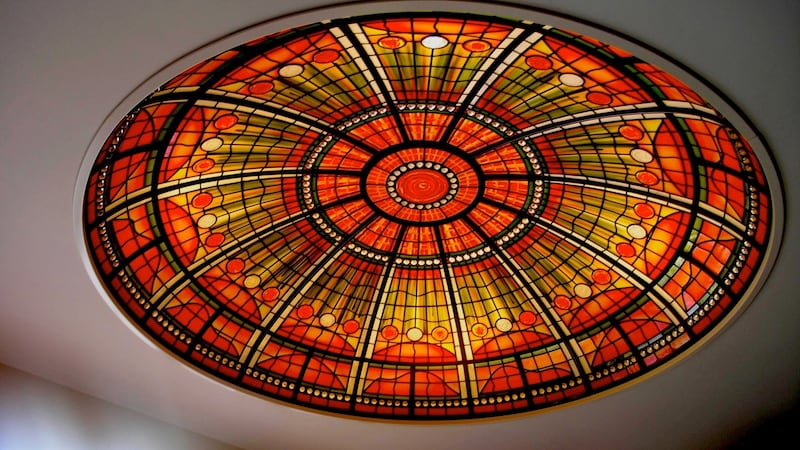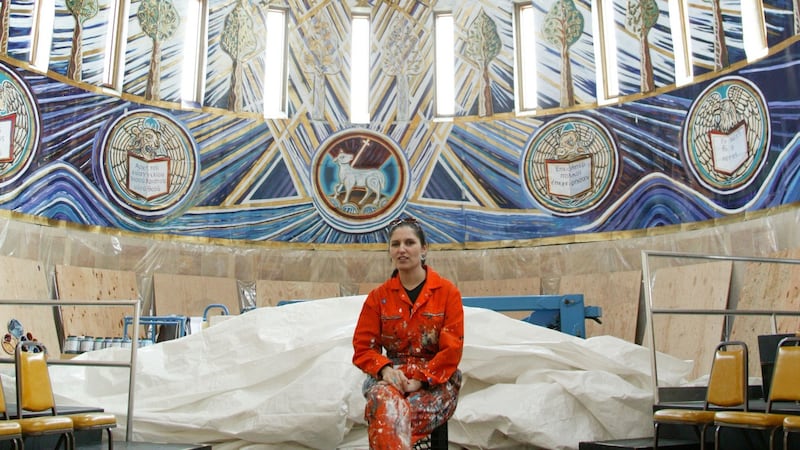“Nothing compares with doing stuff at home. You can travel the world but to come back to install an artwork in your own parish, where your family is based, is very emotional, very fulfilling.” Helen McLean is a painter and a mosaic and stained-glass artist of international standing. Over the years, she has indeed travelled the world, for a series of public art commissions. Earlier this month she returned from Wexford, where she has her home and workshop, to Holywood, Co Down, the town where she grew up. The reason was the installation and dedication of a white glass and 22 carat gold mosaic surround for a specially commissioned icon to Our Lady of Perpetual Help.
Twenty years ago, she was part of the creative team behind the impressive interior of St Colmcille’s Church, also in Holywood, which had been rebuilt after the original Victorian building was destroyed in a fire. Her 189sq ft baptismal wall, depicting a vibrant assortment of birds and animals, scriptural and liturgical references, is one of its most eye-catching features. Her newest piece stands close by in the small side chapel, alongside a floor-to-ceiling height window depicting peacocks and butterflies, symbols of life and the soul.
“When the light shines through that amazing window on to the gold mosaic, it’s as though it is illuminated from the inside,” says McLean. “The gold tradition goes back centuries. There are 20 shades of gold. It is used particularly in a liturgical setting to create a spiritual light and ambiance. It endows the mosaic with a special energy. I go to Venice to purchase my gold; Italy has all the colours in the glass tiles, France and Germany too. But in these financially straitened times, people are cutting back on the number of colours used, to save money. Sad to say, mosaic art, which dates back to 2,000 BC, is a dying art.”


McLean comes from an artistic family. Her late father was church architect Mark McLean, who, coincidentally, was born and raised in Wexford. She is the oldest of three daughters. Her sister Olga is a painter who has lived on Crete for many years, while Fiona, the youngest, works in print design in England.
“My three brothers work as engineers and in computer technology, sensible jobs,” she says. “I have three cousins who are architects. One of them, David McNulty, designs the interiors for the Louis Vuitton stores.
“Coming home this time was more emotional than it would normally have been. My father passed in April. I got the commission for the icon surround just before we lost him. There is a lovely sense of going full circle. He helped me so much over the years and was a great influence and inspiration. He allowed me to make a career as an artist, when other parents would have been steering their children into more conventional lifestyle choices.”
McLean lives and breathes her work, talking with equal enthusiasm about her high-profile commissions, her community projects and her teaching commitments. She fervently believes that the best creativity comes from the heart and the soul, emerging organically out of human contact, collaboration and shared instincts. She describes herself as a people person and says she is happiest when working as part of a team.
Teamwork does not come on a much larger scale than the nine-year artistic and architectural collaboration involved in achieving the breathtaking interior of the Church of the Transfiguration on the shores of Cape Cod Bay, a monastic community in the Benedictine tradition. McLean joined a highly distinguished group that included French stone sculptor Régis Demange, Italian fresco artist Silvestro Pistolesi, German glass sculptor Gabriele Wilpers, bronze sculptors Romolo del Deo and Daphne du Barry, and Italian mosaicist Alessandra Caprara. In a neat cyclical revolve, after graduating in fine art from Lancaster University and completing post-graduate studies in youth work, McLean spent two years in Ravenna, where she was taught the ancient art of Byzantine-style mosaics by Caprara.
The artists were required to understand the spiritual implications and dimensions of the images they were depicting as well as the canons of liturgical art. As master artists they were expected to bring together authentic materials with superb craftsmanship.
McLean was charged with painting the 2,500ft processional path, the apse mosaic of Christ in Glory – in which the face of Christ is five feet tall – the font floor and ambo platform mosaics. She also designed and fabricated the sunrise/sunset stained glass oculus window. She recalls painting on to huge sheets of brown paper, similar to a giant dress pattern. These were then shipped to Ravenna for Caprara and her team to translate into mosaic. She doubts she will ever tackle anything as epic or all-consuming again.
“Unlike other art forms, liturgical art requires the artist to cast aside ego and make work that unites with the architecture, working in the horizontal towards the people and the vertical towards the spirit,” says McLean. “During my time in Cape Cod, I lived closely with the people and absorbed the natural environment, carrying out detailed research into indigenous flora and fauna, which would find their way into the decorative process.”
McLean’s work in mosaic and stained glass is constantly evolving. In recent years, commissions have been completed for hospitals in Limerick and Enniscorthy, a school in Newbridge and a project with Alzheimer’s patients and their carers at the St Brigid’s Centre in Wexford.
“We made a piece that was based on the hands of the sufferers, incorporating elements that represented their lives or interests. One lady had grown up on a farm, another loved dogs, so we made little pictorial references to them in the mosaics of the hands. That way, the partners or carers have something of their loved ones to keep and treasure forever.
“Any commission is a collaboration between the artist and the community. The spirit and intentions of the people effect the artwork, which, in turn, attempts to represent or be a witness to the community’s faith or identity.
“Creativity is as big or as exciting as you want it to be. From Wexford, where I live with my husband and two boys, I can go anywhere to work or source materials. Three years ago, I joined a community of artists in Wiesbaden, Germany, to make the stained glass windows for a chapel in Newtownbutler, Co Fermanagh. The design incorporated the monastic history of the area as well as the musical and song traditions. They have all the modern technology there to bring my full scale paintings into glass. We lived in the studio, we ate together and exchanged ideas and experiences. There were artists there from France, Japan, Germany, Mexico, the United States . . . and me from Ireland.”











